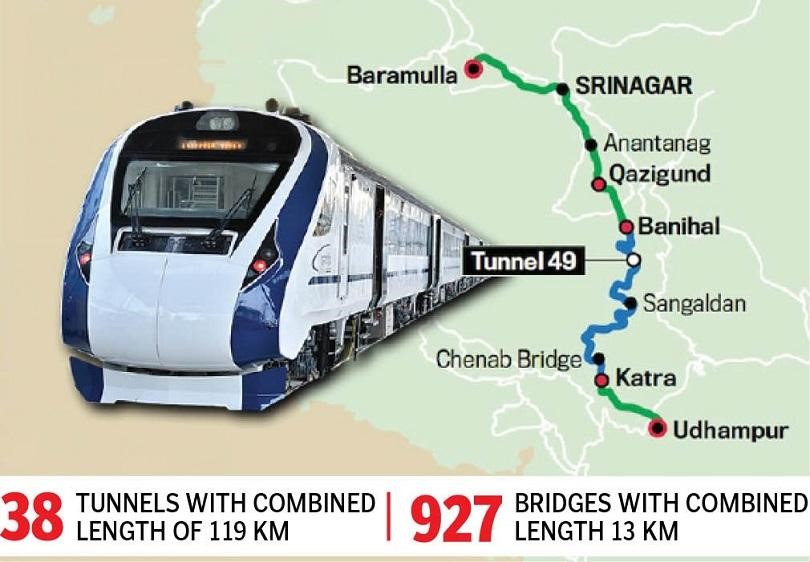Katra-Srinagar Vande Bharat Revolutionises Kashmir Connectivity
Katra-Srinagar Vande Bharat Revolutionises Kashmir Connectivity
Why in the News?
Prime Minister Narendra Modi flagged off two Vande Bharat trains between Shri Mata Vaishno Devi Katra railway station and Srinagar, marking the completion of the Udhampur-Srinagar-Baramulla Rail Link (USBRL). This all-weather railway line will transform connectivity, tourism, and trade in Jammu & Kashmir, significantly enhancing the region’s infrastructure development and promoting regional integration. The project also includes the Srinagar to Baramulla train service, further improving connectivity in the Kashmir Valley. The introduction of the Katra Srinagar train service is set to revolutionize travel in the region, offering a stark contrast to traditional road travel options, as highlighted by recent Jammu Srinagar national highway updates.
Historic Rail Link: Journey of Integration
- The USBRL project was approved in 1995 and declared a national project in 2002.
- Total length: 272 km, built at a cost of ₹43,780 crore.
- Features 36 tunnels and 943 bridges, connecting Katra and Srinagar in just 3 hours, with the Udhampur to Banihal distance being a significant portion of the route, showcasing a remarkable reduced travel time compared to road transport.
- Covers 4 sections: Udhampur-Katra, Katra-Banihal, Banihal-Qazigund, and the Banihal-Baramulla section.
- India’s rail link with J&K was disrupted after Partition; it was gradually rebuilt, culminating in the USBRL, which now provides a crucial Kashmir rail link, including the Jammu Tawi to Srinagar connection and the New Delhi to Srinagar train service.
Engineering Marvels Amidst the Himalayas
- Constructed through seismic zones IV & V, tackling snowfall, steep terrain, and unstable geology in the challenging Himalayan terrain, representing a significant Indian Railways achievement.
- Chenab Bridge: World’s highest railway arch bridge, 359 m above the riverbed, showcasing Indian Railways’ achievement in overcoming engineering challenges. Chenab rail bridge photos and other train images have captured the imagination of people worldwide, illustrating the project’s magnitude.
- Anji Bridge: India’s first cable-stayed railway bridge, also known as the Anji Khad Bridge.
- Country’s longest railway tunnel (12.77 km) built in Ramban district, complementing the famous Pir Panjal tunnel.
- Trains are equipped with heated windshields, insulated toilets, and snow-removal engines to ensure year-round railway access, demonstrating the project’s commitment to remote area connectivity.
- The Katra-Sangaldan stretch and Sangaldan-Baramulla train route incorporate blast-resistant design features, ensuring safety in this sensitive region.
Gamechanger for Economy and Tourism
- Vande Bharat trains between Katra and Srinagar run twice daily, will be extended to Jammu Tawi railway station.
- Will cut travel time in half on the Jammu-Srinagar route and provide year-round, all-weather service, significantly reducing travel time for passengers. This reduced travel time is a key benefit over road transport, as evidenced by recent Jammu Srinagar national highway updates.
- Boosts tourism potential, especially for pilgrims and snow tourists.
- Facilitates faster, cheaper transport of goods like apples, pashmina, and handicrafts.
- Expected to lower cost of essential goods in Kashmir and boost UT’s economy significantly.
The completion of the USBRL project and the introduction of the Katra-Srinagar train service mark a significant milestone in Jammu and Kashmir connectivity. This strategic railway line not only overcomes the engineering challenges posed by the Himalayan terrain but also promises to deliver substantial economic impact and enhance tourism potential in the region.
The Jammu to New Delhi train connection, facilitated by this project, will dramatically reduce travel time and provide a comfortable, year-round transportation option. The Jammu to Srinagar train time table will offer multiple daily services, including the high-speed trains like Vande Bharat Express and the New Delhi Express, making the journey more convenient for travelers and boosting regional integration.
As this infrastructure development project reaches its culmination, it stands as a testament to India’s commitment to enhancing connectivity in remote areas. The Kashmir Valley rail access will not only improve transportation but also contribute significantly to the socio-economic development of the region, ushering in a new era of progress and prosperity for Jammu and Kashmir.
The Udhampur railway station, Reasi railway station, and Sumber railway station are key stops along this transformative route, each playing a crucial role in connecting different parts of the region. Travelers can stay updated on train schedules and any Jammu Srinagar national highway updates through official Railway Twitter handles and local media such as Radio Kashmir Srinagar. The availability of train images and updates on social media platforms further enhances public engagement with this monumental Indian Railways achievement.





